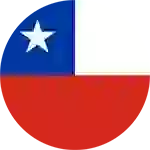Chile
-- Republic of Chile --
Chile officially the Republic of Chile is a South American country occupying a long, narrow strip of land between the Andes mountains to the east and the Pacific Ocean to the west. It borders Peru to the north, Bolivia to the northeast, Argentina to the east, and the Drake Passage in the far south. Chilean territory includes the Pacific islands of Juan Fernández, Salas y Gómez,Desventuradas, and Easter Island.
Chile's northern desert contains great mineral wealth, principally copper. The relatively small central area dominates in terms of population and agricultural resources, and is the cultural and political center from which Chile expanded in the late 19th century when it incorporated its northern and southern regions. Southern Chile is rich in forests and grazing lands, and features a string of volcanoes and lakes. The southern coast is a labyrinth of fjords, inlets, canals, twisting peninsulas, and islands.
Today Chile is one of South America's most stable and prosperous nations. It leads Latin American nations in human development, competitiveness, income per capita, globalization, state of peace, economic freedom, and low perception of corruption. It also ranks high regionally in sustainability of the state, and democratic development.
-- Economy --
The Central Bank of Chile in Santiago serves as the central bank for the country. Chile is one of South America's most stable and prosperous nations, leading Latin American nations in human development, competitiveness, income per capita, globalization, economic freedom, and low perception of corruption.Since July 2013, Chile is considered by the World Bank as a "high-income economy", and hence as a developed country. Its currency is the Chilean peso. In 2006, Chile became the country with the highest nominal GDP per capita in Latin America.
Copper mining makes up 20% of Chilean GDP and 60% of exports. Escondida is the largest copper mine in the world, producing over 5% of global supplies. Overall, Chile produces a third of the world’s copper. Codelco, the state mining firm, competes with private ones. Internal Government of Chile figures show that even when factoring out inflation and the recent high price of copper, bilateral trade between the U.S. and Chile has grown over 60 percent since then.Chile's total trade with China reached US$8.8 billion in 2006, representing nearly 66 percent of the value of its trade relationship with Asia.Exports to Asia increased from US $15.2 billion in 2005 to US $19.7 billion in 2006, a 29.9 percent increase. Year-on-year growth in imports was especially strong from a number of countries-Ecuador (123.9%), Thailand (72.1%), Korea (52.6%), and China (36.9%).
Agriculture in Chile encompasses a wide range of different activities due to its particular geography, climate and geology and human factors. Historically agriculture is one of the bases of Chile's economy, now agriculture and allied sectors like forestry, logging and fishing. Some major agriculture products of Chile includes grapes, apples, pears, onions, wheat, corn, oats, peaches, garlic, asparagus, beans, beef, poultry, wool, fish and timber.[1] Due to its geographical isolation and strict customs policies Chile is free from diseases such as Mad Cow, fruit fly and Phylloxera, this plus being located in the southern hemisphere (having quite different harvesting times compared to the Northern Hemisphere) and its wide range of agriculture conditions are considered Chiles main comparative advantages.
-- Politics --
The current Constitution of Chile was approved in a national plebiscite —regarded as "highly irregular" by some observers— in September 1980, under the military government of Augusto Pinochet. It entered into force in March 1981. After Pinochet's defeat in the 1988 plebiscite, the constitution was amended to ease provisions for future amendments to the Constitution. In September 2005, President Ricardo Lagos signed into law several constitutional amendments passed by Congress. The Congress of Chile has a 38-seat Senate and a 120-member Chamber of Deputies. Senators serve for eight years with staggered terms, while deputies are elected every 4 years. The current Senate has a 20–18 split in favor of the opposition coalition. The last congressional elections were held on 13 December 2009, concurrently with the presidential election. Chile's congressional elections are governed by a binomial system that, for the most part, rewards the two largest representations equally, often regardless of their relative popular support.
-- Trade in Chile --
Major exports of Chile : Refined copper and copper alloys (34%), Gold content (19%), Chemical woodpulp, soda or sulfate, not dissolving grade (3%), Unrefined copper (3%), Grapes (2%)
Major imports of Chile : Petroleum oils, refined (7%), Petroleum oils, crude (6%), Cars (5%), Motor vehicles for transporting goods (4%), Automatic data processing machines (3%)
Major trade partners of Chile (Exports) : China (24%), Japan (11%), United States (10%), Brazil (6%), Korea, Rep. (6%)
Major trade partners of Chile (Imports) : United States (25%), China (15%), Argentina (13%), Brazil (13%), Japan (5%)


